Plush toys are more than just decorations; they are companions that bring warmth and a sense of closeness to their owners. More people are choosing to purchase plush toys, showing an increasingly promising market outlook. Whether you’re in the plush toy business or buying one for personal use, reading this post will smooth your journey.
How are soft plush toys manufactured in the factory?
Among different types of toys, the soft plush toy manufacturing process is quite simple. First, the factory uses machines to cut fabrics and then prints patterns on the fabric using techniques like machine embroidery, screen printing, heat transfer, etc.
Next, the fabric pieces are sewn together to form the shape of a plush toy. Note that there is a place left for the subsequent stuffing. Various materials like PP cotton and bamboo can be used for plush toy stuffing. After filling, it comes to the final hand-sewing to close the filling opening, completing the making of a plush toy.
The most common 9 fabric types for plushies
Cotton plush
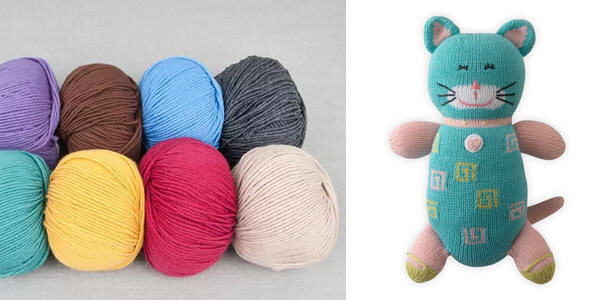
Cotton is widely used for toy surfaces and stuffing material. And you can make a huge variety of colors and patterns in cotton. As a natural fiber, cotton is kind to the skin and it does not cause any choking hazards. It also feels soft and smooth to the touch.
But plushies made of pure cotton easily shrink and deform after washing. Many manufacturers will mix it with other materials like polyester while making toys.
Polyester plush

Polyester is a synthetic material. The stuffing materials of plush toys are mostly polyester, like teddy bears, because it has high strength and resilience. As the surface material, this fabric is not easy to fade and has great color retention. And they are highly durable and wrinkle-resistant. Meanwhile, polyester is not easy to mildew. Compared to cotton, polyester costs less. But it is difficult to dye and easy to pill.
The 2 materials above could form some new types of plush fabrics through different processing methods. Here I explain the 7 most common types.
Super soft plush
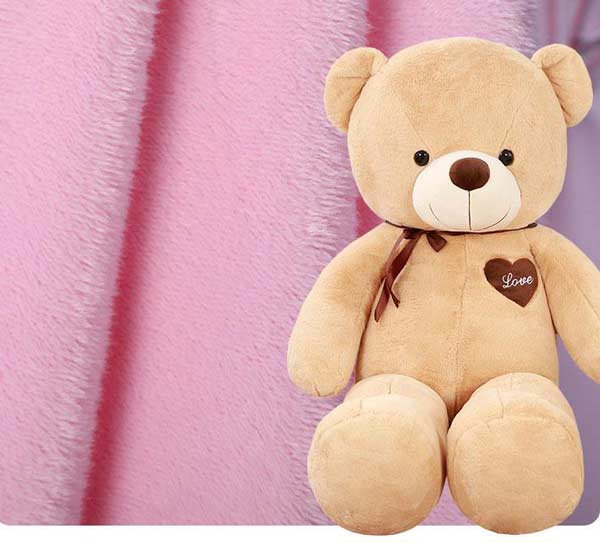
The super soft plush is a fabric by super soft processing, among which crystal super soft plush is widely used in toy manufacturing. Crystal super soft plush has short fur, fine fluff with a strong three-dimensional effect, and a good hand feel. The density between fibers is high. Compared with ordinary super soft plush, this material has higher gloss, a softer hand feeling, stronger fluff, and less fur loss.
Plushies made of crystal super soft plush dry easily when absorbing water. And it is also very convenient to clean, which can be machine washed directly. As for the price, it costs more than other materials because of its complex manufacturing process.
Short plush fabric
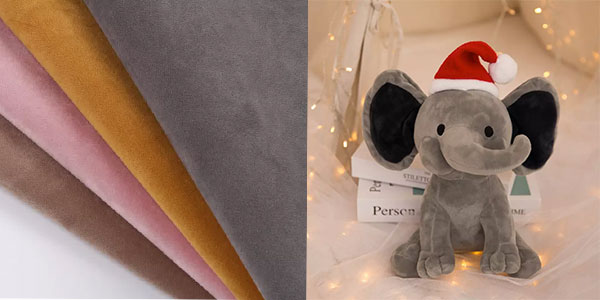
Besides crystal super soft plush, the short plush fabric is another common type of fabric used to produce plushies. It is made from 100% polyester that is knitted into varying weights and pile heights. There are many types of short plush fabric, like minky. This material is durable and not easy to mildew. Its dyeing mostly adopts eco-friendly methods, so the brightness of the color is much higher than that of other fabrics. This fabric is not easy to fade, deform and wrinkle.
Compared with super soft plush, this fabric is less comfortable and the surface is not very delicate and soft. It also costs less than the super soft plush. But it is easy to produce static electricity and pills.
Plush flannel
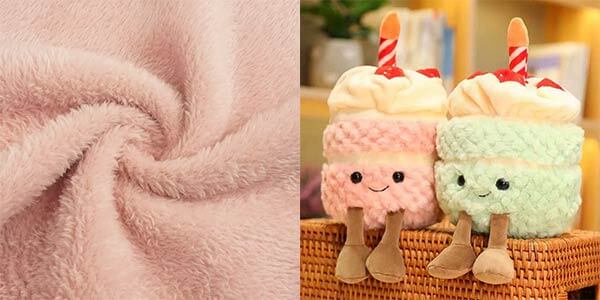
Flannel is another woven fabric, usually made from cotton, wool, or polyester blends. Its features are close to that of short plush fabric. And it has also a similar texture and structure to that plush. It is soft and a little fuzzy. You can make various styles with this fabric and print bright and clear patterns. It is a good choice for creative toys.
But flannel doesn’t have a lot of stretches. And it frays easily and will pill over time.
Fleece plushies
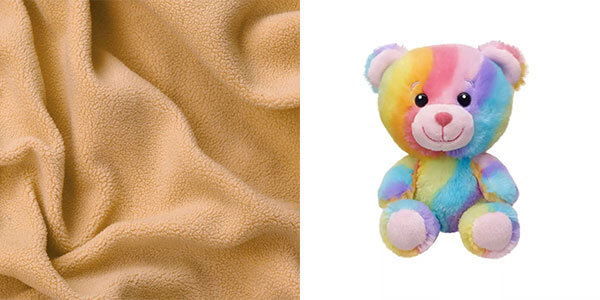
Fleece is a knitting fabric usually made from polyester, which makes it very durable and even relatively waterproof. Fleece is not easy to shed or pill, and it also has good resilience, which is perfect for making squishy plush toys. And this material is also available in a wide range of colors and prints. You can design many cute and interesting toy styles with this fabric.
Fleece costs a little higher because of its complex manufacturing process. Please note that some fleece may be made of poor-quality fabric. So when you use it to make toys, be careful to distinguish between them.
Plush faux fur

As a type of human-made fiber, plush faux fur looks like animal fur. It is more animal-friendly, much easier to process, and costs less. This fabric is light and soft, making plushies in various styles and patterns with bright colors. Meanwhile, plushies made of faux fur are also highly durable. But this material is easy to pill and hide dust. And its water resistance is a little poor.
You will rarely find stuffed animals made entirely from faux fur. It is usually used for some part of a toy, like a lion’s mane as the picture shows.
Faux suede fabric
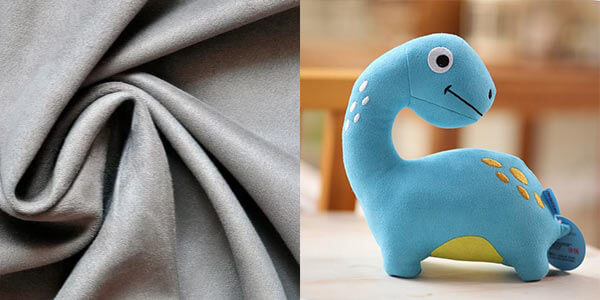
Faux suede is made from polyester microfiber by weaving or knitting. It feels and looks like natural suede, and it is soft to the touch. Compared with real suede, it is easier to maintain. It features bright colors, and good wrinkle resistance. The texture is also light and thin. And it is also not easy to fade or pill. Because of the special manufacturing technology, faux suede costs more than other materials, which makes it one of the popular fabrics for making high-end toys.
But faux suede is not resistant to dirt, and has poor water resistance. Also, it is easy to deform after washing.
Felt plushies

Felt is a strong fabric made of natural fiber like wool or synthetic fibers like acrylic. The price of felt made of different raw materials also varies greatly. The higher the wool content, the stronger the felt and the higher the price.
Compared with other fabrics, the felt is rougher, and it is mostly used to make plushies for decorations. And felt kits for DIY are also popular on the market, which include felt fabric, scissors, needles, etc. This fabric is light and has no grain. It is easy to dye, producing natural and bright colors. Felt is also durable and resistant to wear and tearing. But it lacks stretch and has poor water resistance. Moreover, it easily shrinks after washing.
What factors to consider when choosing plush fabrics?
You’d better consider the following 4 points when sourcing plush toys, whether for personal use or commercial purposes.
Safety
The top to be considered is safety. If the surface of the plush toys is made of inferior materials, it may make formaldehyde exceed the standard. And then it causes strong irritation to the human respiratory tract and skin, causing various inflammations and even cancer. Most people sleep with plush toys, so whether the materials are safe relates to people’s health.
Softness
Plushies should be soft and easy to squash. Many people like plush toys because their warmth and softness can bring comfort and pleasure.
Durability
Another important factor is durability. For example, children always have some violent actions when playing with stuffed animals, such as biting, beating, etc. It requires the seams and small accessories of plushies to be made firmly and not easy to open or fall off.
Meanwhile, the rate of fur shedding should also be of attention. The longer and sparser the fur is, the higher the rate is. And most people are concerned about whether plush toys can withstand numerous washes in washing machines.
Eco-friendliness
Now it’s the focus on whether the materials used in plush toys are eco-friendly. More people prefer those plushies made of eco-friendly fabrics.
Source your premium plush toys
- 20+ years of experience
- Support 4000+ clients
- Strict QC

Very informative blog post.Much thanks again. Great.